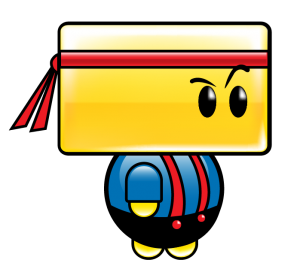
by Annie | Mar 11, 2011 | Game Design
We’re nearing the end of the second week of production, and every day brings more exciting new design challenges. Adrenaline and stress levels are running high as we continue to crank through 12-hour days on coffee and instant noodles. Because we’re so close to our game, constantly nitpicking over every gameplay detail and art asset, it’s sometimes difficult to see the bigger picture. So many variables are up in the air, and we have the awesome yet often terrifying opportunity and responsibility to craft this concept into a fun and memorable game. And that’s why zooming out is so important. Twice a week, instructors and industry mentors come in to check on our progress and offer invaluable guidance, allowing us to take a step back and evaluate our game, to see it for its triumphs and challenges, and to ensure that our efforts and decisions are in line with the vision and goals of our game. To all our instructors and mentors, thank you, thank you, thank you. Your honesty and advice continually push us to new heights as designers. Our game is already infinitely better than it could’ve been without...

by Annie | Mar 9, 2011 | Game Design, Illustration Station
Creating art that effectively communicates gameplay is hard. Not only must functionality and aesthetics work hand in hand, but the visual style must be strong enough to withstand round after round of iteration on game mechanics. Early in preproduction, we knew we had a strong mechanic: a character that throws balls and deflects them with his head to break blocks. However, everyone on the team and everyone we pitched the concept to imagined the game differently. Thus, the art went through several iterations to get to its current state, and certain aspects of the visual style are still undergoing further iteration. One of the earliest art mockups consisted of a small blockheaded character surrounded by blocks and environmental hazards on a single screen. We soon realized that our character needed to communicate more movement, and that perhaps gameplay would extend beyond a single screen. With this mockup, we started to get a sense of the environment around the gameplay. After some experimentation, we created a more whimsical concept, this time with a bolder look and a more memorable character. After further discussions on art and gameplay, we settled on a construction theme, providing more cohesion amongst the elements of the environment. Our current art style aims to communicate both gameplay and function through bold visuals and purposeful design with careful consideration in guiding the player experience. As the mechanics undergo further iteration and tweaking, the art will surely receive further iteration and polish as well. However, by going through multiple rounds of iteration on the visuals and continually going back to the drawing board to push strong visual communication, we’ve...
by Annie | Mar 6, 2011 | Game Design
One of my favorite questions to ask people is what a day in their shoes looks like. And it occurred to me that people might be curious what a day in the life of a game design student looks like, so here goes. First, the disclaimer: of course, there’s no typical day. I’m currently in term 5 of 6, so my team and I are in the midst of production for our final game projects. Thus, our schedule these days consists largely of production tasks rather than classes. What follows is a conglomeration of bits and pieces from the past week, summed up in a single day. 8am Snooze a few times, then get out of bed. Walk the dog. Read news and game blogs while eating breakfast. Start some preliminary research on design/programming issues for the day. 10am Brainstorm design/programming solutions on the bus ride downtown. 11am Stand-up meeting. All team members stand up and share what they worked on yesterday, what they plan to work on today, and quickly bring up any issues they’re having. 11:05am Start working on the game. This week, I’ve mostly been working on programming the main mechanics and features of our game, like character movement, collision issues, implementing our main mechanic, integrating art, and putting in some basic user interface elements. 1pm Project development class. Instructors check on each team’s progress, helping out where they can and pushing us to make the best design decisions possible. 4pm Work with teammates on different design/programming issues. 5pm Street Fighter. I’ll be the first to admit that I’m not a great programmer. My brain can...
by Annie | Mar 1, 2011 | Game Design
Today marks the second day of production for our final game projects, and as of today, we have exactly 80 days to complete our game. Yikes. Needless to say, things are ramping up quickly. If you’re interested, you can follow our game dev progress at http://blokheadgames.com More updates to come. Stay...

by Annie | Feb 24, 2011 | Game Design, Illustration Station
When you’re up late working until 3am and can’t wait to wake up to keep working, you know you’re in the right business. For me, that’s the business of making games. The past couple of weeks have been extremely hectic, to say the least. Juggling the many aspects of preproduction can be quite difficult, especially when there are also several classes crowding your plate. In the past few weeks, I’ve produced countless art assets and taken them through multiple iterations, created diagrams showing the specifics of our gameplay mechanics, and prototyped many of the main mechanics in our game while learning the ins and outs of Unity, all while simultaneously working on a Flash game as well. It makes me tired just thinking about all that work, but I enjoyed every moment of it. And like all hard work in games, I think I deserve an achievement or two, perhaps these: 1. Seeing Ai to Ai With all the vector art I’ve created in the past few weeks, I now know Adobe Illustrator (Ai) better than I ever have. Ai and I, we’re tight. 2. Off on a Tangent Programming brings back all those memories of high school geometry. So first and foremost, a special thanks to Mrs. Jones for making me memorize soh-cah-toa (sine = opposite over hypotenuse, cosine = adjacent over hypotenuse, and tangent = opposite over adjacent). And thank you, Joe, for helping me remember what all that meant. 3. Design on a Dime Everyone loves free stuff. To fill up two buy-six-coffees-get-one-free cards in a single week? Pure heaven. 4. Pitchin’ In I can’t remember...




